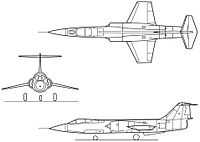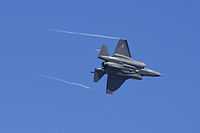Trapezoidal wing
The trapezoidal or diamond wing is a high-performance wing configuration. It is a short (low aspect ratio) tapered wing having little or no overall sweep, such that the leading edge sweeps back and the trailing edge sweeps forward. The trapezoidal design allows for a thin wing with low drag at high speeds, while maintaining high strength and stiffness. To date, all major aircraft to use this design have come from the United States.
History
Early examples provided a solution to the problem of supersonic flight when engine power was limited. The wing of the Douglas X-3 Stiletto was extremely small and thin, giving low drag at supersonic speeds. The principle was adopted for various other X-planes and for Lockheed's widely-produced F-104 Starfighter high-speed, high-altitude interceptor. Lockheed used the design on many of its aircraft proposals in the 1950s, including the Lockheed CL-400 Suntan and early versions of their supersonic transport designs.
The small wing of the Starfighter was found to have good gust response at low level, providing a smooth ride at high subsonic speeds. Consequently the type was adopted for the ground-attack role, notably by the German Luftwaffe. However the small size of the wing resulted in challenging take-off and landing characteristics with a corresponding increase in takeoff and landing accidents.
More recently, a larger and less highly loaded trapezoidal wing has been found to provide good all-round speed, load carrying and manoeuvring characteristics for modern combat fighters such as the Lockheed Martin F-22 Raptor and the VTOL-capable Lockheed Martin F-35 Lightning II Joint Strike Fighter, among others.
Examples
X-planes
Military planes
- Lockheed F-104 Starfighter
- Lockheed Martin F-22 Raptor
- Northrop YF-23
- Lockheed Martin F-35 Lightning II
- Lockheed YF-22
Civil planes
See also
- Sweep theory



